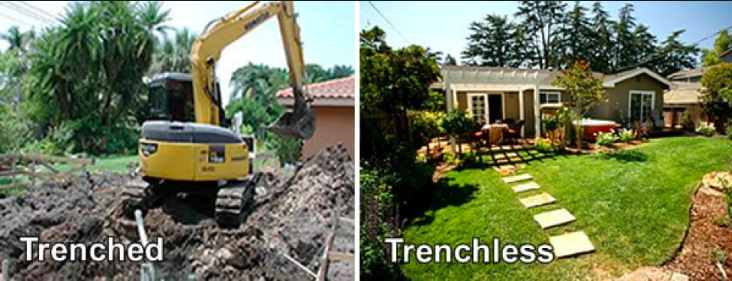Replacing damaged sewer lines can be a huge hassle, but recent technological innovations in the field have made it easier for plumbers to address this serious issue. Known as Trenchless Plumbing, this advanced solution allows homeowners to get the repairs they need without destroying their landscapes or their buildings. Those who are still on the fence about whether or not to jump on board with this trend can read on to find out about a few of the key differences between traditional and trenchless plumbing to decide which one is right for them.
Traditional Sewer Repairs
The traditional methods for repairing or replacing sewer lines can be quite messy and time-consuming. This is uniquely problematic for commercial business owners, who are often forced to disrupt business as usual for an unreasonably long period of time in order to get the repairs they need. Once traditional sewer repairs have been performed, any damage done to the buildings or landscape will also need to be repaired before the property can be returned to its former glory.
Trenchless Sewer Repairs
While traditional repairs can take days or even weeks of work, trenchless sewer repairs can be performed much faster, often in a matter of mere hours. This reduces the amount of disruption that necessary repairs will cause in the lives of business owners and homeowners alike. Working with a contractor that offers trenchless sewer repairs can also help property owners save money, as the process is far less complex than traditional plumbing.
Once trenchless sewer repairs have been completed there will be next to no mess left over. That means there will be no need to hire additional landscaping professionals to come in and clean up excess silt, dirt, and debris or replant trees. Although many property business owners are still opting for traditional repairs because it’s what they’re used to, those who are willing to take the plunge and try something new will find that trenchless repairs are less expensive, less destructive, and less stressful.
Not all plumbing companies are able to perform trenchless repairs. Readers who want to take advantage of this advanced alternative to tearing up their lawns and unearthing damaged pipes can find out more about Sacramento plumbers who do offer the service online.
Hard Water Trenchless Water HeatersFAQ – Frequently Asked Question
Trenchless Plumbing
Trenchless plumbing refers to a method of repairing or installing pipes without the need for excavation or digging. This method utilizes modern technology and techniques to solve plumbing problems with minimal disruption to the surrounding area.
Trenchless plumbing uses specialized equipment to access and repair pipes from the inside. This can involve using pipe bursting, pipe lining, or directional boring methods. The equipment is inserted into the existing pipe and repairs are made without the need for excavation.
The benefits of trenchless plumbing include reduced disruption to landscaping and surrounding areas, faster repair times, increased durability of pipes, and lower overall cost compared to traditional plumbing methods.
Trenchless plumbing is typically faster, more cost-effective, and less disruptive compared to traditional plumbing methods, which often require excavation and extensive digging. Trenchless plumbing is also more environmentally friendly and can be used in a wider range of situations.
Trenchless plumbing can be used to solve a variety of plumbing problems, including leaks, clogs, corrosion, and broken pipes. It can also be used to install new pipes, repair sewer lines, and replace damaged or aging plumbing systems.
Trenchless plumbing can be more expensive than traditional plumbing methods for small repairs or installations, but it is often more cost-effective for larger projects or repairs that would require extensive excavation. Additionally, the reduced need for excavation can result in lower landscaping or property restoration costs.
While trenchless plumbing is an effective solution for many plumbing problems, there are some situations where traditional plumbing methods may be more appropriate. Trenchless plumbing is not recommended for large-scale excavation or when access to the pipes is limited.
Trenchless plumbing repairs and installations are typically designed to last for decades, with warranties ranging from 10 to 50 years depending on the specific method used and the materials used for the repair or installation.
Some common trenchless plumbing methods include pipe bursting, pipe lining, and directional boring. These methods involve different techniques for accessing and repairing pipes without excavation, and the most appropriate method will depend on the specific plumbing problem and the condition of the existing pipes.




